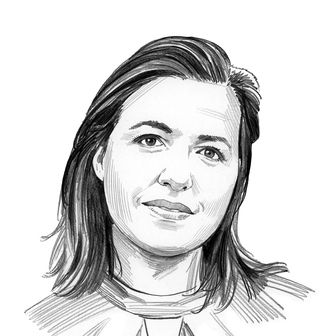
From a building closed to the public except for essential personnel, where lawyers are allowed to argue only if they have a negative PCR test, six vaccinated, boosted conservative justices of the Supreme Court blocked the Biden administration’s vaccine-or-test requirement for workplaces. There is some internal dissension on the Court’s COVID-related precautions: Recent arguments have featured one justice with a high-risk condition (Justice Sonia Sotomayor, diabetes) calling in rather than sit next to a justice who refuses to mask (Justice Neil Gorsuch, chronic jerk). Still, from a workplace transformed, an unsigned majority opinion declared that COVID-19 is “not an occupational hazard” for most of the covered businesses, that it is “a threat that is untethered, in any causal sense, from the workplace.” The three Democratic appointees dissented.
Chief Justice Roberts and Justice Brett Kavanaugh, who sometimes like to make a show of their reasonableness, did join the liberals in a separate case heard the same day, upholding the administration’s vaccine mandate for health-care workers.
Technically, the cases turned on the question of whether a particular branch of the federal government had authority to impose these requirements in a pandemic that has, as the dissenters in the broader workplace case plainly point out, “killed almost 1 million Americans and hospitalized almost 4 million.” The health-care-worker case was easier to make in the eyes of Roberts and Kavanaugh: Medicaid and Medicare funding gives the government the power to set conditions, and their patients are uniquely vulnerable.
In the case regulating all workplaces over 100 employees, the federal Occupational Safety and Health Administration, or OSHA, has the ability to issue an emergency standard when employees are “exposed to grave danger from exposure to substances or agents determined to be toxic or from new hazards,” which sounds a lot like COVID-19. All of the conservative justices insist that what OSHA imposed in response is a “vaccine mandate,” even though there are plenty of ways to get out of it: testing negative weekly; working from home, alone, or outdoors; even claiming religious or medical exemptions. They say the rule is unprecedented, “a significant encroachment into the lives — and health — of a vast number of employees.” Then again, so is the pandemic.
They point out you can also get COVID-19 somewhere else, although with a few exceptions, like school for students, they are places where people have a choice to go. As the dissenters note, at work, “individuals have little control, and therefore little capacity to mitigate risk.” But the conservative majority shows more concern for the supposed “billions of dollars in unrecoverable compliance costs” and “hundreds of thousands of employees” who they say will quit — a number that has shrunk wherever mandates are already in place and reality has interfered — than for the workers inhaling the aerosols of untested, unvaccinated colleagues in close quarters. Or, for that matter, the systems that are buckling under providing their care.
The dissents in each case tell a story of a Court urgently struggling not just with the question of federal power in a pandemic, but with the authority of the Court itself and who, exactly, has become “untethered” in the exercise of power.
“And then, there is this Court. Its Members are elected by, and accountable to, no one,” write Justices Sotomayor, Elena Kagan, and Stephen Breyer in their joint dissent to the OSHA case. (I’m not the only one who thinks it sounds a lot like the now-oft-exasperated Kagan wrote it.) They add, “When we are wise, we know enough to defer on matters like this one. When we are wise, we know not to displace the judgments of experts, acting within the sphere Congress marked out and under Presidential control, to deal with emergency conditions. Today, we are not wise.”
Meanwhile, in Justice Clarence Thomas’s dissent on the health-care case, joined by Justices Gorsuch, Amy Coney Barrett, and Samuel Alito, it is the government that has vastly overreached. To require two or three quick shots to reduce one’s chance of infection and infectiousness, of disease and death, is actually to “compel millions of healthcare workers to undergo an unwanted medical procedure,” and “to force healthcare workers, by coercing their employers, to undergo a medical procedure they do not want and cannot undo.”
For those of us bracing ourselves for the Court’s all-but-certain rollback of abortion rights — the outright denial of a much-wanted medical procedure in favor of an infinitely more coercive, invasive, and life-changing alternative, forcing someone to stay pregnant and give birth — this was sick irony. As law professor Liz Sepper pointed out, Barrett explicitly made the analogy during the court’s recent abortion arguments, casually referring to forced pregnancy as “an infringement on bodily autonomy, you know, which we have in other contexts, like vaccines.” We haven’t yet been treated to Barrett’s rationale for why the state’s encroachment on pregnant people is the acceptable tradeoff for life, whereas vaccines are the overreach.
The pandemic, we are told, will not last forever. But as today’s opinions make clear, the reordering of authorities and priorities, the brazenness of what the Court has done and seems ready to soon do, will long remain.






























